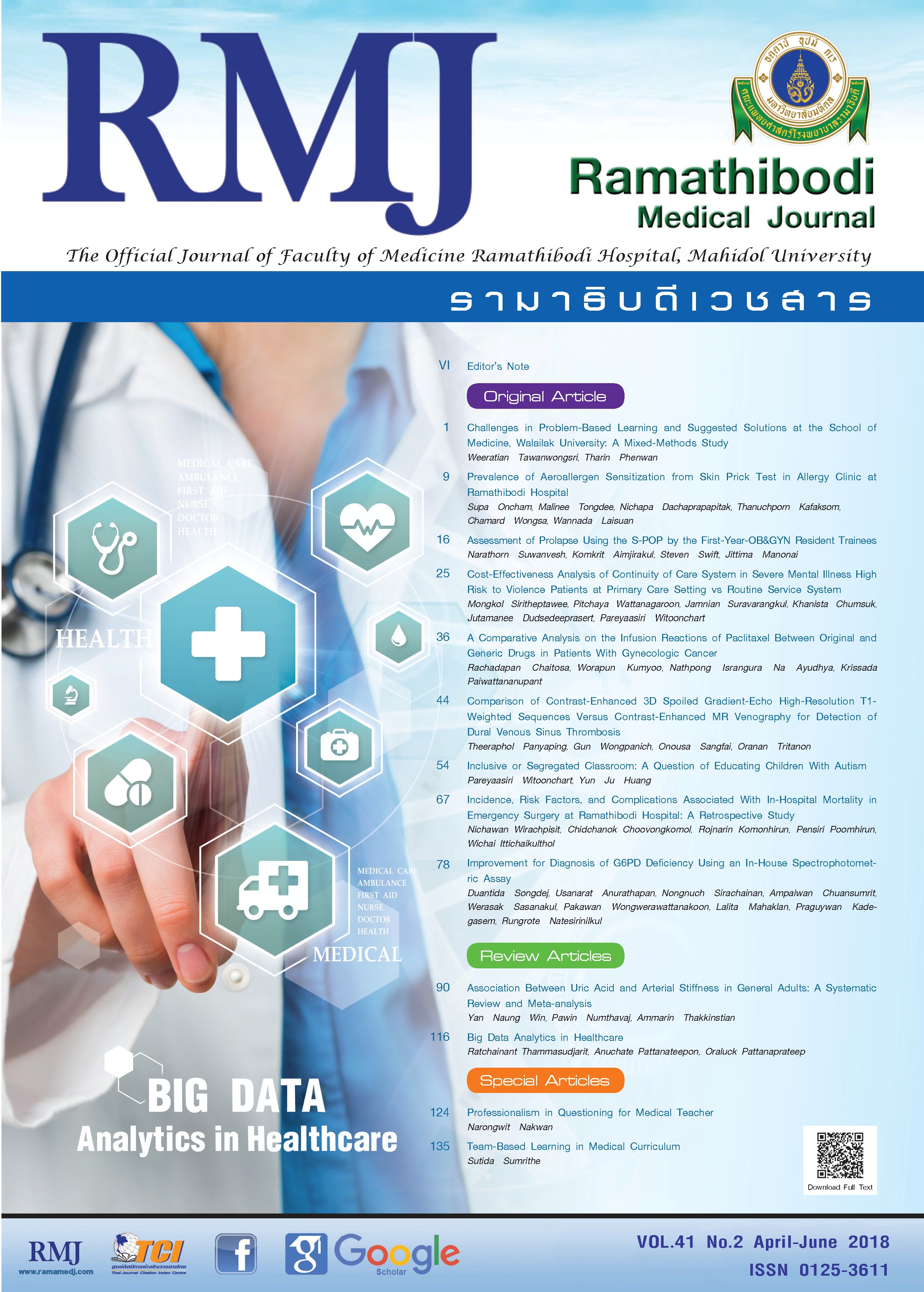Assessment of Prolapse Using the S-POP by the First-Year-OB&GYN Resident Trainees
DOI:
https://doi.org/10.14456/rmj.2018.12Keywords:
Pelvic organ prolapse, Simplified pelvic organ prolapse quantification system, Pelvic organ prolapse quantification systemAbstract
Background: The pelvic organ prolapse quantification system (POP-Q) is a relatively complex and it is often interpreted as being difficult to learn. An international committee devised a simplified version of the POP-Q (S-POP) classification system that retained the ordinal stages of the POP-Q system but simplified the terminology and reduced the number of points measured.
Objective: To determine the correlation between POP-Q and simplified version of POP-Q (S-POP) in patients examined by urogynecologists and first-year-obstetrics and gynaecology (OB&GYN) residents, respectively.
Methods: A cross-sectional study was conducted in 100 subjects with or without symptoms of pelvic floor disorder, attending the Urogynecology Clinic at Ramathibodi Hospital. Subjects underwent two separate pelvic examinations at that visit; POP-Q examination by urogynecologists, and S-POP examination by the first-year-OB&GYN residents. The ordinal stages from each segment were recorded and the inter-system agreement was evaluated using kappa analysis.
Results: According to the POP-Q system, pelvic organ prolapse overall stage I, II, III and IV were demonstrated in 8%, 54%, 27% and 11%, respectively. Regarding the intersystem agreement, kappa statistics for overall stage was 0.77, for the anterior vaginal wall was 0.79, for the posterior vaginal wall was 0.78, for the cervix was 0.73, and for the vaginal cuff was 0.56.
Conclusion: There was substantial agreement between the POP-Q examination by urogynecologists and the S-POP examination by first-year-OB&GYN residents.
References
Bump RC, Mattiasson A, Bo K, et al. The standardization of terminology of female pelvic organ prolapse and pelvic floor dysfunction. Am J Obstet Gynecol. 1996;175(1):10-17.
Muir TW, Stepp KJ, Barber MD. Adoption of the pelvic organ prolapse quantification system in peer- reviewed literature. Am J Obstet Gynecol. 2003;189(6):1632-1635.
Auwad W, Freeman RM, Swift S. Is the pelvic organ prolapse quantification system (POPQ) being used? A survey of members of the International Continence Society (ICS) and the American Urogynecologic Society (AUGS). Int Urogynecol J Pelvic Floor Dysfunct. 2004;15(5):324-327.
Pham T, Kenton K, Mueller ER, Brubaker L. Current use of pelvic organ prolapse quantification by AUGS and ICS members. Female Pelvic Med Reconstr Surg. 2011;17(2):67-69. doi:10.1097/SPV.0b013e318207c904.
Oyama IA, Steinberg AC, Watai TK, Minaglia SM. Pelvic organ prolapse quantification use in the literature. Female Pelvic Med Reconstr Surg. 2012;18(1):35-36. doi:10.1097/SPV.0b013e31823bd1ab.
Manonai J, Mouritsen L, Palma P, Contreras-Ortiz O, Korte JE, Swift S. The inter-system association between the simplified pelvic organ prolapse quantification system (S-POP) and the standard pelvic organ prolapse quantification system (POPQ) in describing pelvic organ prolapse. Int Urogynecol J. 2011;22(3):347-352. doi:10.1007/s00192-010-1286-y.
Lemos N, Korte JE, Iskander M, et al. Center-by-center results of a multicenter prospective trial to determine the inter-observer correlation of the simplified POP-Q in describing pelvic organ prolapse. Int Urogynecol J. 2012;23(5):579-584. doi:10.1007/s00192-011-1593-y.
Sung VW, Hampton BS. Epidemiology of pelvic floor dysfunction. Obstet Gynecol Clin North Am. 2009;36(3):421-443. doi:10.1016/j.ogc.2009.08.002.
Walker GJ, Gunasekera P. Pelvic organ prolapse and incontinence in developing countries: review of prevalence and risk factors. Int Urogynecol J. 2011;22(2):127-135. doi:10.1007/s00192-010-1215-0.
Treszezamsky AD, Rascoff L, Shahryarinejad A, Vardy MD. Use of pelvic organ prolapse staging systems in published articles of selected specialized journals. Int Urogynecol J. 2010;21(3):359-363. doi:10.1007/s00192-009-1044-1.
Oyama IA, Steinberg A, Watai T, Minaglia SM. Pelvic organ prolapse quantification use in the literature. Female Pelvic Med Reconstr Surg. 2012;18(1):35-36. doi:10.1097/SPV.0b013e31823bd1ab.
Parnell BA, Dunivan GC, Gellar EJ, Connolley AM. A novel approach to teaching the pelvic organ prolapse quantification (POP-Q) exam. Int Urogynecol J. 2011;22(3):367-370. doi:10.1007/s00192-010-1299-6.
Steele A, Mallipeddi P, Welgoss J, Soled S, Kohli N, Karram M. Teaching the pelvic organ prolapse quantitation system. Am J Obstet Gynecol. 1998;179(6 Pt 1):1458-1463.
Swift S, Morris S, McKinnie V, Freeman R, Petri E, Scotti RJ, Dwyer P. Validation of a simplified technique for using the POPQ pelvic organ prolapse classification system. Int Urogynecol J Pelvic Floor Dysfunct. 2006;17(6):615-620.

















